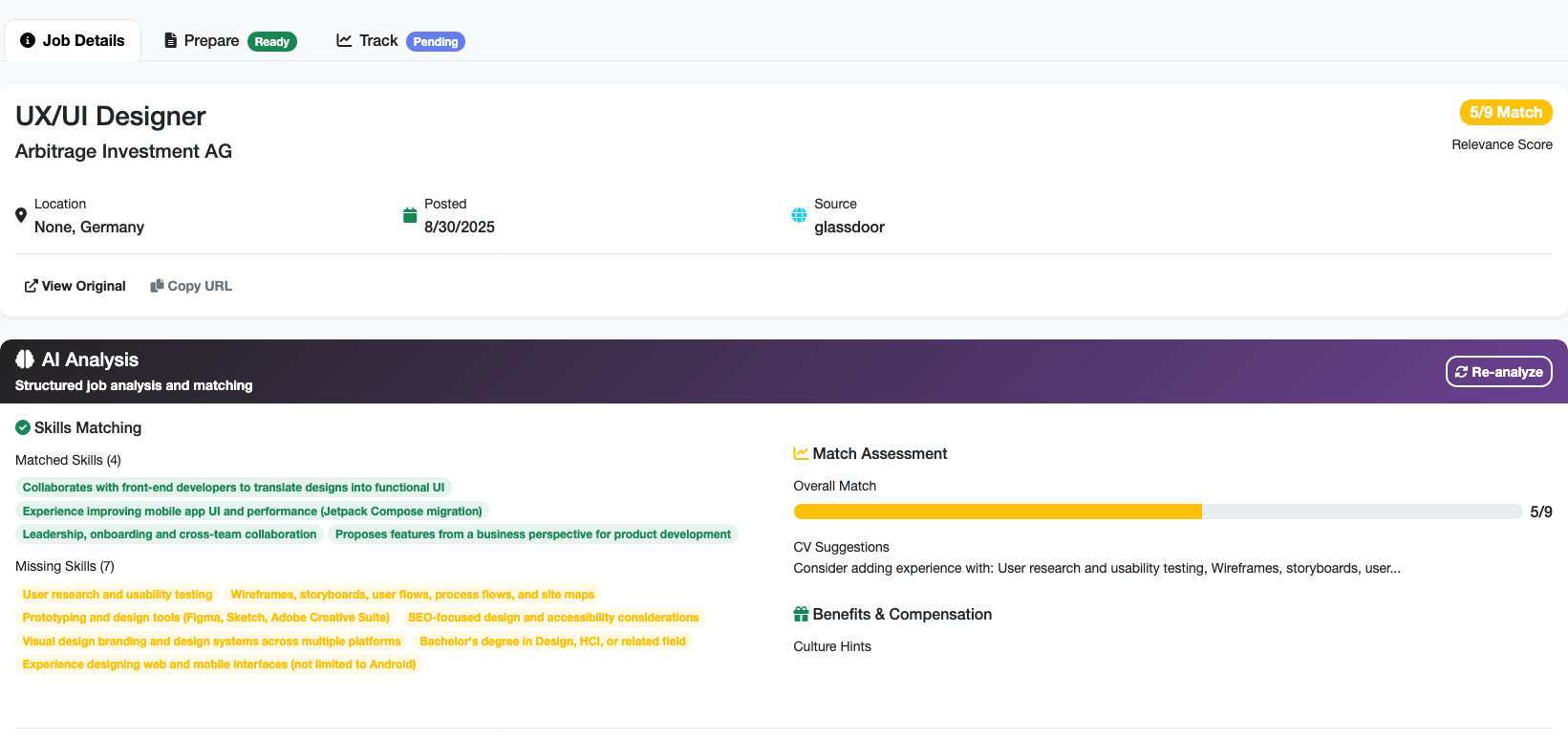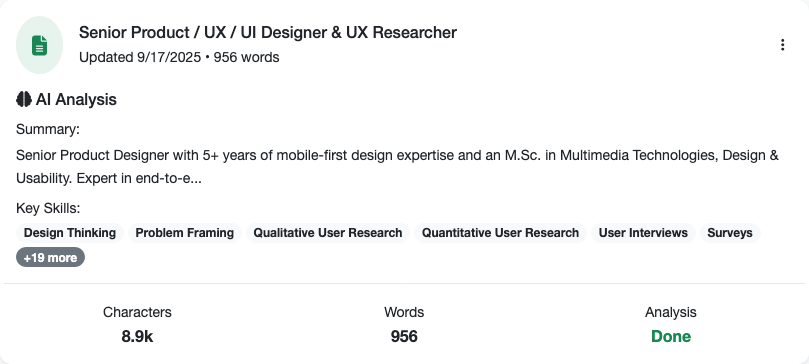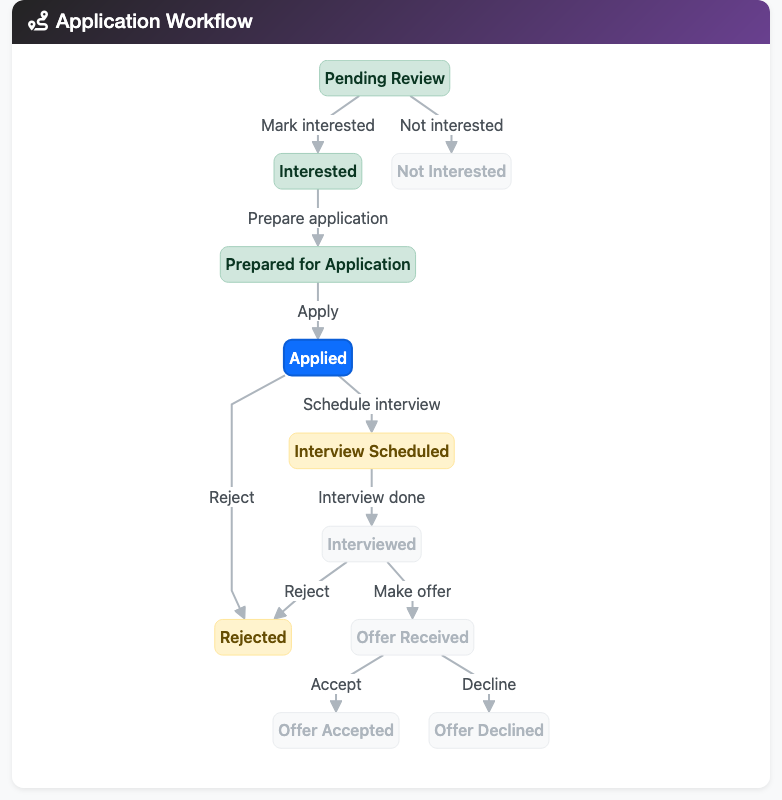Intelligent Job Search Assistant
A smart job-search platform for mid and senior professionals that eliminates irrelevant listings, continuously scans opportunities, and provides actionable insights to accelerate career advancement.

Impact at a Glance
Overview & Challenge
Mid and senior professionals face critical pain points in job searching: wasting hours scrolling through irrelevant listings, missing newly posted opportunities, and receiving rejections due to generic applications. Traditional job boards offer limited filtering, no continuous monitoring, and zero personalization.
Core Problem Statement
How might we help experienced professionals find relevant job opportunities efficiently while providing insights that improve their application success rate and reduce time wasted on irrelevant listings?
Research Insights
Spend 10–15 hours weekly on job search with low conversion
Want automated relevance filtering and continuous monitoring
Send non-tailored applications due to time constraints
Won't trust "black box" matching algorithms without explanations
My Role & Responsibilities
As Lead UX/UI Designer working with a founder/developer and early adopters, I:
- Conducted in-depth user research with 15+ mid and senior professionals to identify core pain points and workflow gaps.
- Defined product strategy, information architecture, and feature prioritization based on research insights.
- Designed end-to-end user flows for job discovery, matching, tracking, and analytics modules.
- Created high-fidelity UI designs covering 40+ screens and states with comprehensive edge case coverage.
- Established a scalable design system with 20+ components to ensure consistency across web and future mobile views.
- Ran iterative usability testing with 10+ participants, improving task success rates by 35%.
- Collaborated closely with development, maintaining 95%+ design fidelit
Design Process
1. Discovery & Research
Methods: In-depth interviews, journey mapping, competitor analysis
Key Finding: Only 15–20% of job listings are relevant to users' experience level, yet professionals spend 10–15 hours weekly browsing.
2. Problem Definition & Strategy
Core Value Propositions:
- Intelligent Matching: AI-powered relevance scoring with transparent criteria
- Continuous Scanning: 24/7 monitoring across multiple job platforms
- Actionable Insights: Performance analytics to improve application success
3. Information Architecture & User Flows
Architecture Coverage:
Job Feed, Tracker, Insights, Settings
End-to-end user journeys
Error states & exceptions
Card sorting validation
4. Visual Design & Design System
Design System Elements: Cards, filters, status badges, charts, data visualizations, responsive layouts
5. Usability Testing & Iteration
3 Testing Rounds | 10 Participants
Simplified status tracking from 5 to 3 steps: improved clarity and reduced confusion.
Clarified match scoring transparency : increased user trust in AI recommendations.
Enhanced filter discoverability: boosted search efficiency and filter usage.
Key Features Designed
Intelligent Job Matching
Relevance scoring interface showing why each job matches user profile, with transparent criteria breakdown and confidence indicators.
Continuous Scanning Dashboard
Real-time feed displaying newly discovered opportunities with smart notifications and customizable scanning frequency.
Performance Analytics
Comprehensive dashboard visualizing application success rates, response times, and market trends to guide strategy improvements.
Application Status Tracking
Intuitive Kanban-style tracker with manual status updates, timeline view, and quick-action shortcuts for efficient pipeline management.
Advanced Filtering System
Multi-criteria filters (seniority, salary, location, remote options, company size) with saved search presets for quick access.
Company Insights Module
Detailed company profile views aggregating culture data, interview tips, and hiring patterns from multiple sources.
Key Interface Highlights
 |
 |
User Journey: From Discovery to Success
User defines career goals, preferences, must-haves, and deal-breakers
Platform crawls job boards 24/7, analyzing new postings against user profile
Relevance algorithm scores matches with transparent reasoning and confidence levels
Users manage pipeline with Kanban-style tracker, updating status manually
Analytics dashboard reveals success patterns, helping users refine strategy
Results & Impact
Additional Achievements
- ✓ User satisfaction 4.3/5 among beta testers for interface clarity
- ✓ 30% reduction in support questions through improved navigation
- ✓ 50% less time spent on irrelevant listings with continuous scanning
- ✓ 95% design fidelity maintained through detailed specs and collaboration
- ✓ Status tracking simplified from 5 steps to 3 steps
Design System Highlights
Key Learnings & Design Decisions
Transparency Builds Trust
91% of users demanded clear explanations for why jobs matched their profile. We designed visible match criteria breakdowns with confidence indicators, turning a "black box" into a transparent recommendation engine.
Simplification Through Testing
Initial designs had 5-step status tracking that confused users. Iterative testing revealed 3 steps were optimal, reducing cognitive load while maintaining necessary functionality. Sometimes less truly is more.
Data-Driven Prioritization
Research showed 78% of users spent 10–15 hours weekly with poor results. This quantified pain point helped prioritize continuous scanning and intelligent filtering as MVP features over nice-to-have additions.
Progressive Disclosure
Rather than overwhelming users with all filter options upfront, we implemented progressive disclosure patterns that revealed advanced filters only when needed, keeping the primary interface clean and approachable.
Reflection & Next Steps
Deep user research proved essential in understanding the real friction points mid and senior professionals face. The emphasis on transparency—particularly around match scoring—built user trust and differentiated the platform from competitors. Close collaboration with development ensured technical feasibility while maintaining 95%+ design quality.
Upcoming Features (Q2–Q3 2025)
- Email Tracking: Automatically capture application status changes from inbox
- One-Click Applications: Streamlined submission workflow reducing friction
- AI Interview Prep: Mock interview simulations with personalized feedback
- Company Culture Deep-Dive: Expanded insights aggregating Glassdoor, Blind, LinkedIn data
- Mobile Native Apps: iOS/Android for on-the-go job discovery and notifications
Continued A/B testing and analytics monitoring will drive data-informed refinements as the user base grows. The design system foundation enables rapid iteration while maintaining consistency across future features.